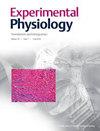Prolonged effects of a post-synaptic blocking fraction of Naja siamensis venom of skeletal muscle of the mouse.
Quarterly journal of experimental physiology and cognate medical sciences
Pub Date : 1978-01-01
DOI:10.1113/expphysiol.1978.sp002413
引用次数: 7
Abstract
A sublethal dose of a post-synaptic blocking fraction of Naja siamensis venom was injected into the soleus muscle of the mouse inhibiting neuromuscular transmission for 2-3 days. The paralysed soleus muscle behaved as if denervated, developing extra-junctional sensitivity to acetylcholine and accepting innervation by an implanted foreign nerve. Since the only known action of the post-synaptic blocking fraction of this venom is due to its affinity to acetylcholine receptors, the results suggest that the spread in the sensitivity of muscle fibres to acetylcholine and their ability to accept a foreign nerve is a consequence of neuromuscular blockade.
小鼠骨骼肌突触后阻断部分的作用。
在小鼠比目鱼肌注射亚致死剂量的突触后阻断部分,抑制神经肌肉传递2-3天。瘫痪的比目鱼肌表现得好像失去了神经,对乙酰胆碱产生了连接外的敏感性,并接受外来神经的支配。由于这种毒液的突触后阻断部分的唯一已知作用是由于它对乙酰胆碱受体的亲和力,结果表明肌纤维对乙酰胆碱的敏感性和它们接受外来神经的能力的扩散是神经肌肉阻断的结果。
本文章由计算机程序翻译,如有差异,请以英文原文为准。
求助全文
约1分钟内获得全文
求助全文

 求助内容:
求助内容: 应助结果提醒方式:
应助结果提醒方式:


